-
Posts
881 -
Joined
-
Last visited
-
Days Won
48
Content Type
Profiles
Forums
Blogs
Gallery
Downloads
Articles
Media Demo
Events
Posts posted by lukeamdman
-
-
Here's a test notnyt wanted me to run on a channel of the 12k.
20hz at 3.5ohm for 12 seconds:
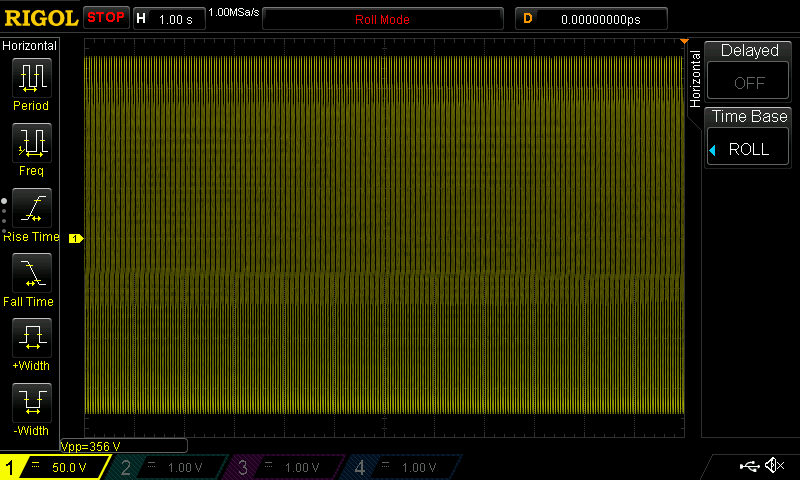
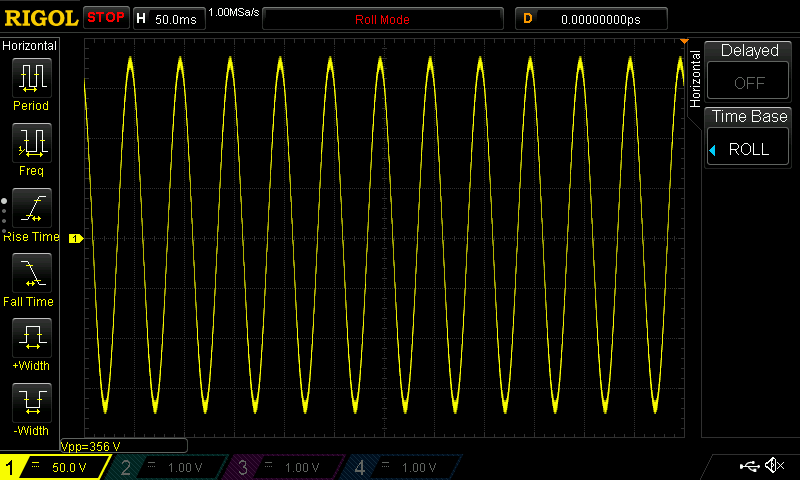
Maintains 356Vpp (125.8Vrms / 4,521w) for the entire 12 seconds...
Amp ice cold, fans idle.
-
 1
1
-
-
Nice. Hopefully spreading the power out across a lot of drivers helps minimize the impedance changes that occur. How much excursion do you think the drivers were seeing for these tests?
For 10hz maybe 1/2"?
-
Did some CEA burst tests for the first time. This is on a single channel of a SP2-12K.
First I wired all eight 21s into a single 1.5ohm load and ran an impedance sweep in WT2:
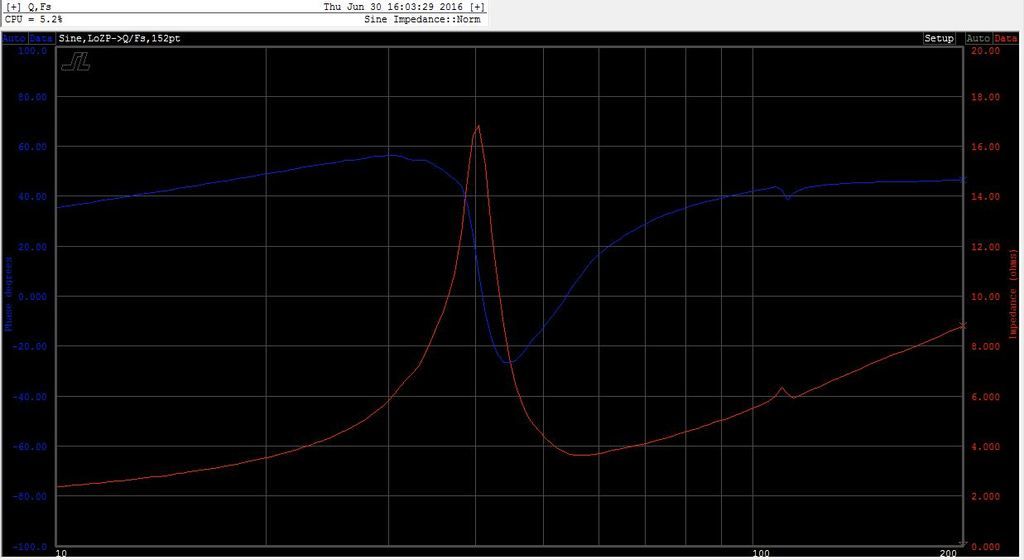
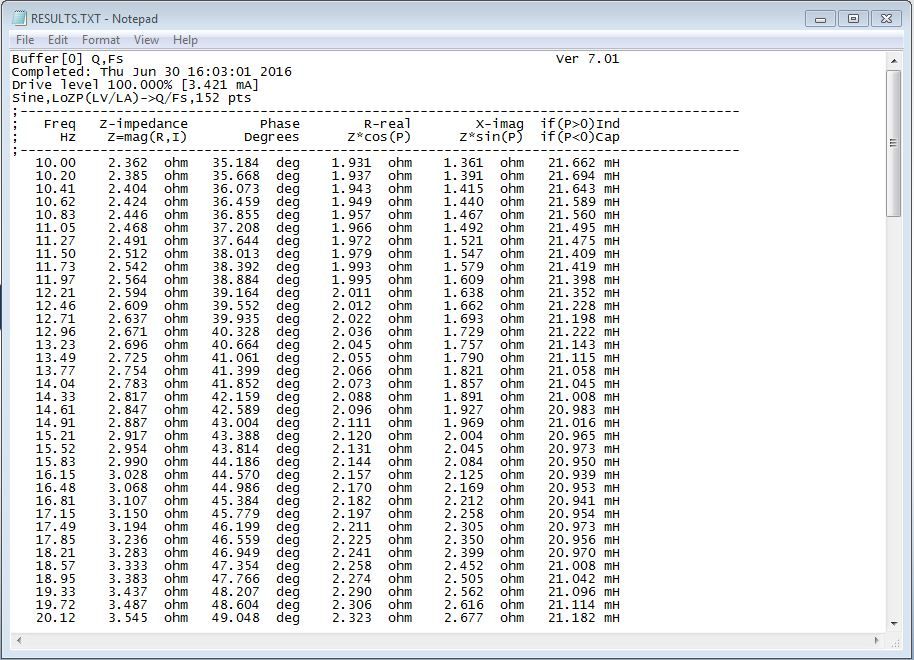
I did some CEA testing at 10hz (2.36ohm) and 20hz (3.54ohm).
10hz:
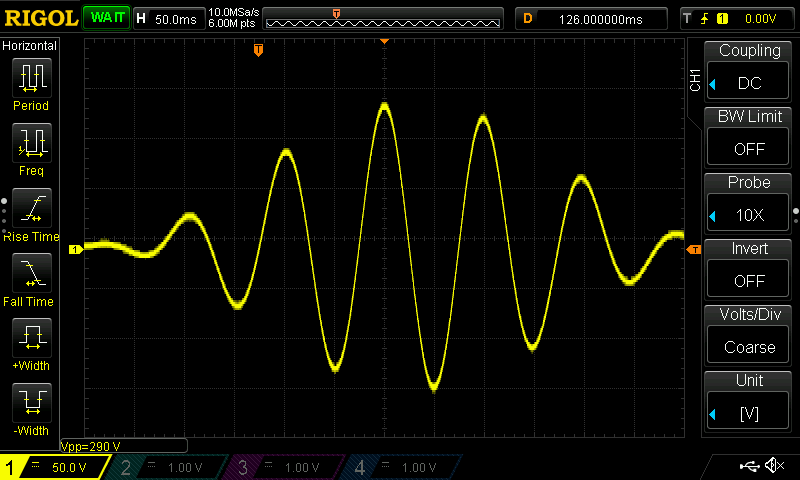
290Vpp = 102.5Vrms into 2.36ohm = 4,451w
20hz:
And I somehow deleted the first screenshot!?!?!?
Anyway, 358Vpp clean with no clip lights
358Vpp = 126.5Vrms into 3.54ohm = 4,520w. Also, the spec sheet for these amps says 127Vrms, so this test seems spot on.
I then pushed 0.5db further and got 384Vpp and a brief flicker of the clip light. Sure enough, tiny bit of distortion in the peak of the wave form:
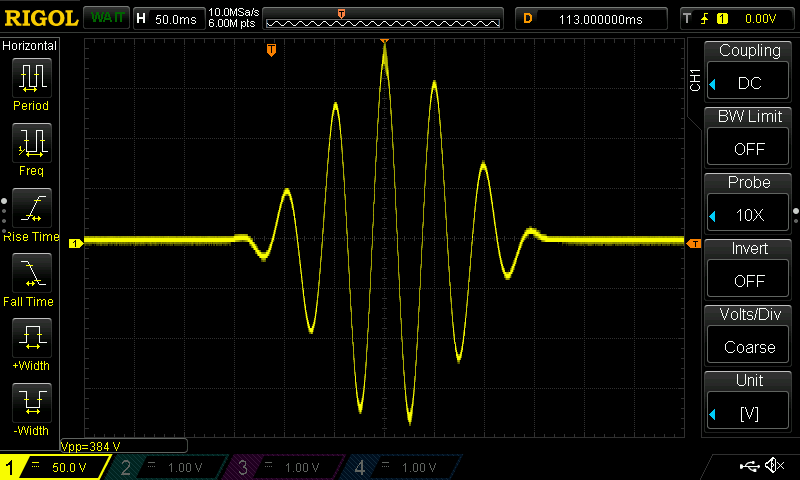
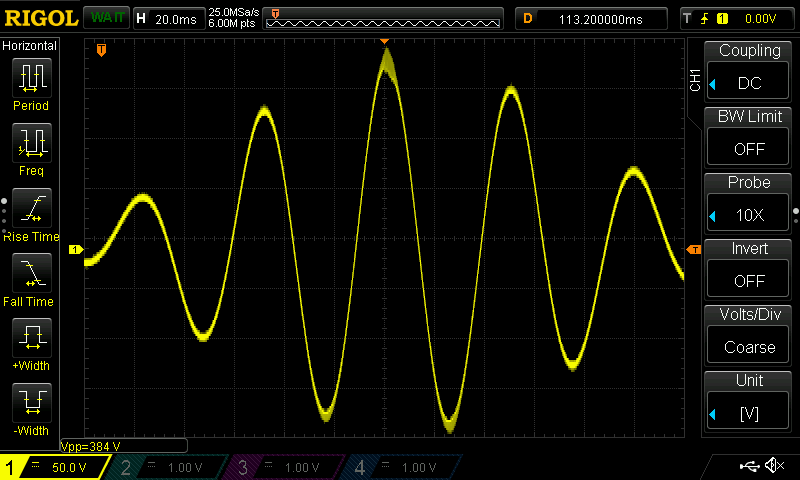
384Vpp = 135.7Vrms into 3.54ohm = 5,201w
-
 1
1
-
-
I've been messing with the scope again this week and I think I (well not really me, but a suggestion from notnyt) found out why the Rigol was reading a little higher votages than the Flukes. Here's what I measured before:

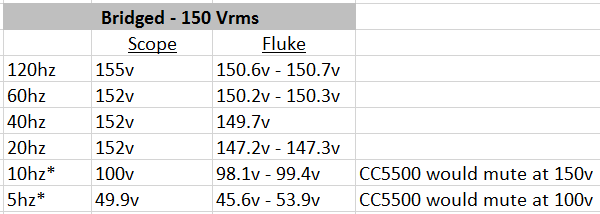
Apparently there's a High Resolution setting on the Rigol and that seemed to level the playing field between the scope and flukes. I'm going to to re-test the above numbers and report back.
Also, and it's unfortunate, but the 87V doesn't oscillate any less than the Fluke 115/117 at 10hz and 5hz...arggg.....
-
I don't know how the noise floor of the 10x10HD compares to the OpenDRC-AN, but I did find the noise floor of the OpenDRC-AN to be excessively high for me to use with high sensitivity speakers. I'm surprised that the MiniDSP stuff is so widely recommended as I have had a variety of issues with the products, but I guess it makes sense given the lack of affordable alternatives.
I agree. They seem to work for a lot of people but the 2 units I tried a few years back I had a number of issues with. They just weren't for me.
I think they're popular because they're low cost and are one of the only DSPs on the market that let you set PEQ and XO below 20hz without extra workarounds. They also have a frequency response that's pretty much flat to DC.
As you've pointed out there are definitely some downsides though. The unbalanced 2x4 lacks voltage headroom, and my balanced 2x4 did have some pretty nasty "thump" when powering on and off. Even that balanced 2x4 would benefit from more voltage headroom.
My first 10x10 board was actually missing components on the PCB. The noise floor was even higher and there was some really high frequency noise (above 20khz) that kept the amps signal lights lit up constantly. They did send me a new board, and my only issue with the 10x10 now is the noise floor when trying to full active with high efficiency mains.
I've seen the capability and flexibility of using the Motu/JRiver combination from mojave and it's really impressive, but I don't want to rely on running absolutely everything through JRiver.
-
SME,
Sorry, just getting caught up on this thread, but so far your experiences have already answered some questions I had!
First, it's too bad the OpenDRC-AN has a loud noise floor. I tried to go full active with a 10x10HD and the noise floor was just too much. I could hear the hiss outside the room! I've been trying to think of how to get that last 1% of performance out of my mains, and I was contemplating FIR EQ, but the OpenDRC-AN has now been scratched off the list...
Second, the Motu 16A is on my list to replace the 10x10, but it has some downsides. From what I've gathered, it does have 4 bands of PEQ on both the input and output of each channel (so really 8 total), but it doesn't have low-pass filters? Since you're fully active, how have you been implementing a LPF with the Motu?
-
Josh, I wonder if my system resonance being right at 40hz was causing some of the voltage oddities at 40hz?
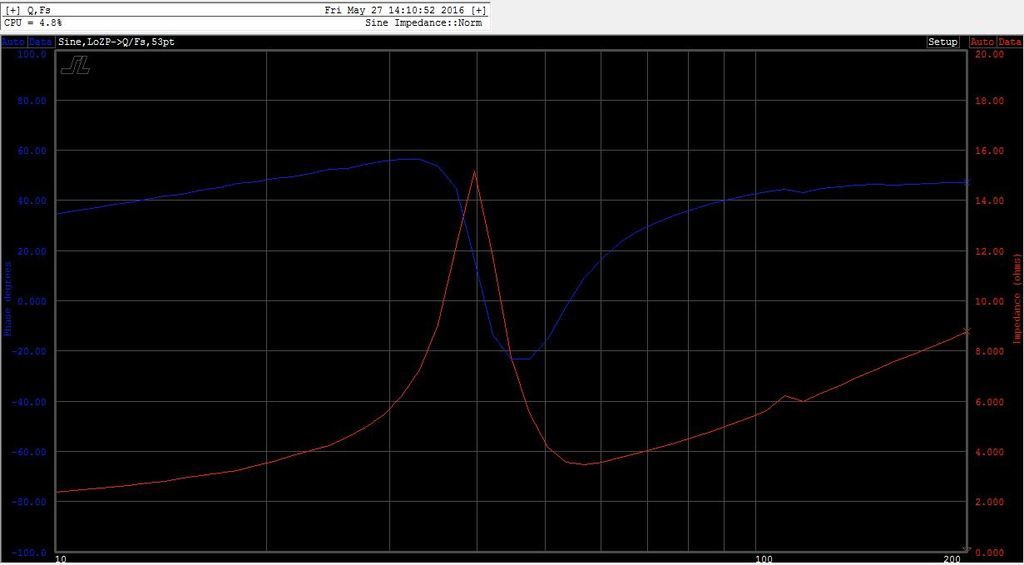
-
Peavey CS 4080HZ (red) vs. Crest CC4000 (blue)
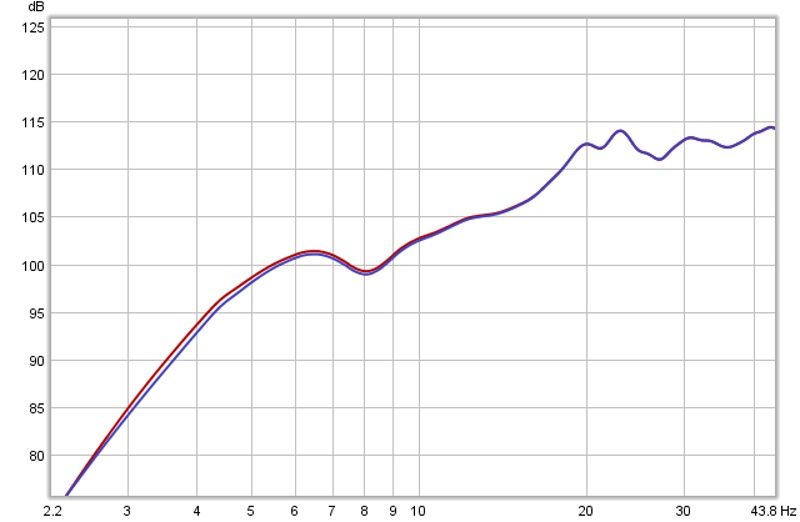
-
On 5/27/2016 at 11:45 PM, Stormwind13 said:
Good, now we can see peavey numbers :-p
Peavey 4080 is a beast!

Testing done at 20hz.
-
 3
3
-
-
Good, now we can see peavey numbers :-p
Today is the day! Getting things setup to test it right now.
4ohm 1ch driven
4ohm both ch driven
8ohm bridge
frequency response
-
Received the Smith and Larson WT2 today. Neat!
This is certainly a lot easier than doing impedance sweeps one frequency at a time with a pair of DMM! lol
-
Why aren't these loaded in PaleHorn's yet?!
-
In other news...I've been out twice this week. I'll be posting the results for the Aura NS18 soon and some other things.
I also tried to run the 21IPAL driver through testing again. This time I crammed 2 in the tiny 5.5ft dual opposed sealed cab I previously used for the 21SW152's, so I could get a 2ohm nominal load for the amp. The K20 still current limited well before getting to the driver limits. Not surprising since the minimum impedance is dropping down near 1.5ohms and the amp is rated for 4ohm bridged. Thankfully those amps are so well protected they won't let you blow them up even when you do something stupid. Next time I'm out and going to let one channel of the SP2-12000 have a go at this cab and see if it does any better.
I was going to say...try the SP amp

I've driven my IPALs to what looked like near 3" peak to peak excursion with a SP2-12000!!
-
It's part of the design of the scope to have ground terminals of all channels wired together and to the main earth ground. It would be unsafe not to.
In the above image, you can see that the black side of probe 2 is on the other side of the load from the black of probe 1, which is your problem. There is huge potential between those two when they are on either side of the measured load. As to why this happens, the resistance on a single probe from + to - (where the scope measures it) should be around 1 megaohm, so it can measure high voltages without things smoking, but the grounds between two probes on separate channels are probably < 1 ohm (you can continuity from the outside of two BNC barrels on the scope with your fluke to confirm).
In the image below, I reversed where you're clipping red and black on probe 1. I think that should keep your scope happy with the grounds always at the same potential (but I would carefully test starting at low output; I am not an EE), and you'll be able to capture live real-time data the way the good lord intended. You can also click Invert on any channel in the rigol to turn things back right-side up.

While you're doing that, it would be neat to see THD at various levels from the amp. I know you can hit MATH -> FFT to view the full harmonics of a signal in db scale below the main graph, but I'm not sure if it spits out THD measurements. Probably. In any case, this setup would be worlds neater and easier than copying down fluke readings with pencil and paper.
I did successfully test the rig with the resistor on the the ground side, but I ran into the issue again with bridged amps since in that configuration there isn't a "ground level" connection...
Besides purchasing a very expensive low voltage differential probe to overcome that, I'll have to stick with the DMMs. The 87V is getting calibrated this week.
-
ok ok...I'll buy WT2 already! Jeepers


-
Before I even start anymore testing I'm going to get my 87 calibrated. I don't think it's off or anything, but it'd be nice to have the peace of mind that the numbers are accurate.
Lucky for me I have a buddy who works at a machine shop, and he used to work for the calibration company that tests/calibrates all their tools!
-
Let me get this straight, you just bought a Fluke 87V to go with your Fluke 115 and Fluke 117 but haven't ponied up for a DATS system yet? Really?

Bwahaha! Exactly.
What the hell Luke? I think this might explain some things. Spend $150 and get a Smith & Larson WT2 if you want an easy button. I would pay the extra for this over the DATS or WT3. I've had all 3. Or save some money and wire up a voltage divider network like figure 2 in the attached pic and use REW or go ahead and get the ARTA suite for LIMP for next to nothing. Either way you shouldn't be manually plotting impedance 1Hz at a time in 2016.

-
That's a nice piece of equipment.
Going back to the voltage results a bit. If it were me the first thing I would do is get a baseline for what you are using to record the voltages and remove variables. Forget about high power and voltage and using the speakers hooked up at first. Use a small signal like 3 volts straight out of the amp or a generator and check the readings at various frequencies. Baseline a 55Hz then try 100, 30, 20, 10, 5Hz etc. Any reasonable amplifier or generator should be flat 200 to 20Hz within a very small window. If your meter is measuring variation from 200Hz to 20Hz it is likely not accurate.
If everything checks out ok there hook the subs and rest of the chain back up and try the same deal once again at a low level consistent voltage. Baseline at 50-60Hz again and change nothing other than the frequency being used. Make sure that you aren't getting weird voltage readings that don't make sense. It should be consistent regardless of frequency until well below 20Hz where you'll start to see a reduction at the lowest frequencies.
Also it looks like your impedance measurements might be done by hand and then plotted or something? Forgive me if that's not the case but I noticed that they look a bit odd too. Especially the Othorn one. It's missing a peak which only shows up as a tiny bump.
I think this post got lost in the mix a few pages back:
http://data-bass.ipbhost.com/index.php?/topic/476-lukes-basic-amplifier-tests/?p=12560
I did run voltage tests without any subs connected with both the scope and the Fluke plugged right into the amp to compare the results:

As you can see, from 20-120hz the voltage only changes by 0.02v. At 10hz and 5hz you begin to see my signal chain roll-off (Marantz AV7005 + MiniDSP 10x10) which is expected.
Here's what I think is going on, and take the SP2-12000 for example:
Brian lists the voltage output at 126Vrms, which equates to almost exactly 2,000w at 8ohm (rated power spec for 8ohm). I was able to squeeze 127Vrms at 40hz (5.5ohm)and 131Vrms out of that amp at 20hz (4.5ohm). BOTH of those voltages exceed the spec sheet of that amp, which would also explain the distortion I saw in the wave form.
With the XLS, and without any subs connected to the amp, it hits the brakes at ~100-102Vrms. According to Crown's specs, it should be able to reach 111Vrms without any load connected to meet specs (rated at 1,550w at 8ohm). However, my testing lasts for several seconds, so I'm not surprised the Crown falls a bit short (It was only $299 new!!).
I'm going to re-test with the Fluke 87V, but additionally, I'm going to list the maximum Vrms the amps will produce at 40/20/10/5hz without any subs connected first. After that, then I'll test with a load connected.
And yes, my impedance charts are done 1hz at a time with me imputing the readings into a spreadsheet...I should just buy DATS already!
-
Josh, I'm seriously jealous of the power cord that came with your SP2-12K...
My first SP2-12K came with a 14/3 cable with a NEMA-15 plug (15A)...
My second SP2-12K I just received today came with another 14/3 cable, but this time with the L6-20 (20A)...
I just ordered another Tripp Lite L6-30 10AWG cable to replace the 14awg like I did with the first amp.
-
Kind of an impulse buy, but I got a used Fluke 87V off eBay. It has a frequency range of 0.5hz-200khz, so we'll see if it oscillates below 20hz like the 117/115.
-
I think new is slightly charitable frankly! It remains a pretty terrible circa 2000 website.
What is the difference between the DP and HT models? Is it just that HT means the different front end? Is it a DSP? Any impact on performance (eg rolloff)? I couldn't see specifics on that.
The "HT" version looks to have typical controls you'd find on a consumer grade sub amp. Things like gain, crossover, delay, etc.
On the "DP" version I think you're limited to just gain knobs for each channel.
EDIT: The "HT" version also has the standard 15A plug and RCA inputs. Pictures of each here:
-
Whole new SP website today.
-
Can you please point me to these updated spec sheets? I can't seem to find them.
http://www.speakerpower.net/uploads/4/9/5/7/4957539/spec_sheet_sp_rack_amps_dp.pdf
-
Typically an amp will have a voltage limit set by the rails and power supply. Say you have amplifier X and it is capable of 50 volts prior to clipping. Since the amplifier operates as a constant voltage device the current demands increase into lower impedances and at some point the amplifier cannot provide enough current to meet the demand to maintain the voltage required at say something like 1ohm. The current is the limitation. If the impedance is higher say 16ohms or something, the current demand is a small fraction of what it was into the lower impedance and the amp is not being asked for much power. In that case you will be limited by the voltage capability of the amp. There is a sweet spot of overlap where most amplifier are able to produce maximum voltage, current and power. It is odd to see a lower voltage limit at a higher impedance. I can't recall seeing that in any amplifier test before. The voltage limit should be constant to my knowledge once it is the limitations instead of the current.
I am not an expert on amplifiers but this is my understanding of modern amplifiers.
I completely agree on all counts, but I think with the XLS and SP2 I was hitting the voltage limits.
Without any load connected I can only get ~100v out of the XLS, and the spec sheet for the SP2 says ~126v from what I recall, which would explain the clipping I saw on the scope.




Luke's basic amplifier tests
in Bass Gear
Posted
Those tests are good. The "High-Resolution" thing did lower the voltage a bit, but for the voltages the XLS was putting it was probably only ~2v.
For the CEA burst stuff I just tested, those are the starting resistances, and with a reactive load like my subs the resistance will go up with more power. Think of those CEA numbers as a best case number.
Maybe I should get some heater elements and a bucket! That's was nice about a non-reactive load, the impedance doesn't change with frequency.